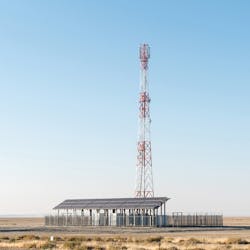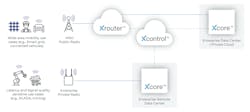Private/Public Wireless Advances Sustainability Initiatives

PGE Integrates Public Wireless Into Its Private Network and Sustainability Wins
Sustainability has been a major issue for mobile network operators, which expend more than 90% of operational carbon footprint to power public wireless networks. The bulk of this energy consumption happens in the RAN. GSMA Intelligence estimates that even in a best-case scenario, mobile networks are on course to almost double power consumption between 2020 and 2025, thanks to 5G growth.
With this in mind, GSMA Intelligence suggests that for operators, “energy conservation and emission reductions are not just a social responsibility but also a critical requirement for energy cost savings.” The organization’s analysts point to a rapid increase in wholesale energy prices further forcing operators to make energy efficiency a priority. They say operators that delay necessary full-scale energy-efficiency transformation or fail to embed energy efficiency as part of digital network transformation initiatives will endanger long-term competitiveness.
Against this backdrop, MNOs and standards bodies have taken significant steps to increase network sustainability. For instance, 5G’s increased dependence on automation could play a role in reducing mobile’s outsized carbon footprints. The technologies themselves, such as 800 Gigabit Ethernet, are also becoming more energy efficient. Shared-use public clouds could further improve energy efficiency by 93% compared to on-premises IT infrastructure, according to Microsoft.These investments could pay dividends for enterprise sustainability efforts, especially as organizations across industries prep private wireless network deployments. Enterprises that leverage existing public mobile infrastructure to serve next generation use cases could come out on top when it comes to keeping carbon footprints low.
Private, Public or Both?
Enterprises typically build private wireless networks wherever they need connectivity. That could entail acquiring spectrum licenses for each area being served, building new base stations, leasing towers, backhauling networks, permitting and so on. Then there is the cost of hardware and software, as well as ongoing operational expenses, including hiring and training teams of engineers and subcontractors.
Let’s face it, projects like that take years to complete, require substantial upfront capital outlays and then must be operated, managed and maintained for 10-20 years. And don’t forget the energy cost of operation, which can be high and volatile.
Historically, there have been good reasons for enterprises to follow the build-it-yourself path, such as concerns about public network performance, security, and manageability, as well as the ability to serve mission critical functions. This is changing as private wireless networks leveraging public mobile networks adapt to enterprise demands.
Today’s LTE and 5G networks are overcoming public mobile concerns and are being designed for higher efficiency. They can serve mission critical needs with redundant networks that provide fail-over resiliency and are managed with performance SLAs. Public networks and data centers are also supported by tens of thousands of dedicated engineers.
In addition, mobile operators are investing in the edge and network slicing to support use cases that require low latency and high throughput. And 3GPP standards are enabling powerful network security.
As a result, enterprises can now have the best of both public and private worlds. They can take advantage of public wireless networks to expand reach without building proprietary networks and deploy their own private networks only where it makes economic sense.
Using software, public wireless connectivity can be integrated into private networks and IT operations to provide a secure virtual private network that offers unprecedented simplicity, agility and control. The network provides the same seamless experience regardless of whether the device is connected to public or private cellular base stations, and enterprise IT can configure and manage their cellular devices with their usual processes.
By taking advantage of existing LTE and 5G networks, enterprises can make the most of existing infrastructure, take advantage of economies of scale and minimize staffing needs in a tight labor market.
Sustainability also benefits significantly. Using the MNO’s multitenant radio network means sharing towers, racks and sheds, as well as the power that those radios are already using. It also means taking advantage of the energy-efficiencies that accompany 5G.
Portland General Electric (PGE) Case Study
One company that has been successful with this approach is utility PGE in Oregon. PGE (portlandgeneral.com), a fully integrated energy company with operations across Oregon, has taken steps to accelerate grid modernization and renewable energy outcomes by integrating public wireless into its private network.
PGE’s mandated decarbonization targets include an 80% decrease in greenhouse gas emissions associated with serving Oregon retail electricity consumers, compared to its baseline emissions levels, by 2030The utility sought private wireless network coverage over the next five years is extending over 4,000 square miles and containing 250,000 connected grid elements. The company also needed to cover 930,000 utility meters serving 2.5 million customers.
The PGE private wireless network will support automated grid resiliency, monitoring of field conditions with smart sensors and devices, connected workers for enhanced employee safety and charging stations for electric vehicles on the public grid.
“5G’s increased dependence on automation could play a role in reducing mobile’s outsized carbon footprints. The technologies themselves, such as 800 Gigabit Ethernet, are also becoming more energy efficient. Shared-use public clouds could further improve energy efficiency by 93% compared to on-premises IT infrastructure, according to Microsoft.”
The utility determined it had a choice between making a large capital outlay on a new network that would take many years to build or using those funds to increase renewables and grid applications that will immediately grow the business and save energy costs.
PGE decided not to build its own wireless network. Instead, it extended its private network via tier one mobile operators. The platform they used makes it possible to leverage public mobile connectivity, yet people and devices will “see” just one unified private network.
How does it work? One platform by Expeto does it by making it simple for enterprises to seamlessly extend their existing networks over any combination of MNO operated public and enterprise-owned privateRadio Access Networks (RANs) needed to meet their application coverage, bandwidth and latency requirements.In this scenario, a device with a single-SIM is assigned the same enterprise private address and subnet regardless of whether it is attached to a public or private RAN.Rather than struggle to manage this mobile connectivity with legacy telco tools that require LTE/5G user expertise, enterprises get an IT-centric portal purpose-built for enterprise agility and speed.Expeto’s open and extensible NeXtworking Platform embeds elements of a mobile core (i.e., EPC, 5GC) that can be deployed for secure and scalable connectivity behind a corporate firewall, in a private or public cloud, at the edge or geographically remote sites depending on use case requirements. It supports creation of secure network segments, management of subscribers and network policies, and monitoring of network usage and performance. It enables enterprises to increase IT productivity, boost agility, reduce capital expenditures and deploy quickly. Furthermore, the platform takes into account the concerns of Mobile Operators (MXOs) who want a solution that integrates once with their public RAN and scales to extend “behind the firewall” self-service network control to many enterprises.
PGE confirmed viability of intended use cases during year-long extensive tests at its Connected Utility Lab. The results validated connectivity, performance, coverage and security. Since the deployment took place in the cloud using existing infrastructure, no additional hardware was required. This was an important step toward energy conservation.
The company will be able to choose between private and public wireless for each use case and manage them all through a single console.
The resulting private radio network has the scalability needed to support the large number of grid nodes (e.g., DERS, EV charging stations) and devices (e.g., wildfire risk monitoring cameras, AMI) necessary to achieve carbon reduction, resilience, and safety goals.
By deciding not to effectively become another wireless carrier in the region, PGE estimates its CAPEX and OPEX savings can be used to accelerate use of renewable energy sources, digitize the network, and create a more efficient grid.
Seamless integration of public and private networks provides an important opportunity to support the growth of sustainable, energy efficient networks.
Rather than proliferating many new private wireless network buildouts, network infrastructure, resources, and operating expenses can be consolidated and shared.
That is good for business. And good for the planet too.
About the Author
Brian Anderson
VP of Product, Expeto Wireless
Brian Anderson is a pioneer in the IoT/M2M market with over 25 years of experience in software product creation. His current role as the VP of Product at Expeto Wireless is a culmination of his past successes in disrupting markets with groundbreaking software solutions. In this position, he leads the overall innovation, execution, product management, and customer success initiatives globally for the Expeto team. For more information, please visit www.expeto.io. You can also follow them on Twitter @expetowireless and LinkedIn: https://www.linkedin.com/company/expeto-wireless.
